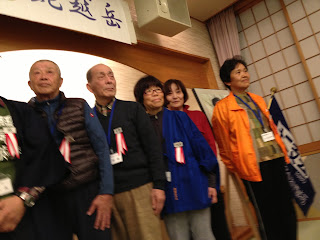Edith Marcombe Shiffert is a minor American poet. Minor in this case means that, tho she is well known, her fame resides mostly within poetry circles. She has published many books, several with my print illustrations in them. Her style is modern but not rash or affronting. There is a melancholic feeling to many of her poems. But they are not about love or related themes; rather about nature, the outdoors, the countryside, insects and animals. She wrote some haiku occasionally, but found it too easy.
A little of her life story can be read here: <http://simplyhaiku.com/SHv7n1/reprints/Wieman.html> This was written by Jane Wieman back in 2007, so some of the information is not current now. She moved into a large Kyoto City Municipal care home a few years ago, and is pretty much confined to a wheelchair. She is very healthy, but does not write at all now.
For Edith's 97 (estimated) birthday, the care home wanted to give her a small afternoon party in her favorite French restaurant, Reborn. She and her late husband, Minoru, used to go there often. I, too, have shared lunch there with them. Edith wasn't able to attend herself; the care home brought to the party her lovely and beautifully dressed body in her wheelchair, with exquisitely done up white hair, full toothless smiles and ever bright, even sparkling eyes, and Edith's always gesturing hands.
12 guests attended, including Edith's helper, a young, vivacious and very capable woman, two of Minoru's four sons (one brought his wife), and assorted friends who have known Edith for decades. We each greeted Edith, some gave her birthday gifts, held her hands, laughed at her not remembering who we were or where she was, and in general appreciated this wonderful opportunity to share her with like-minded friends. Photos were taken before, during and at the end of the party. We ate a delicious citrus ice cream pudding dish, a small piece of her birthday cake, and rather good coffee. Sufficient fare for the occasion.
Here are the names of the guests: John Einarsen, Judith Clancy, Koka Saito the painter, Morris Augustine, Barbara Stein, Papa Jon's Charles, Lois Karhu, myself.
Edith with Morris and Judith, holding my print.
Left to right in foreground: Barbara, Charles, Lois, John.
Morris on Edith's right.
With Judith.
On left, one of Minoru's sons, talking with Koka Saito the painter.
It saddened me, probably all of us, to see a once great poet, a fantastic woman, a truly rare human being, in an otherwise healthy body, but with no memory or awareness of her circumstances. Edith remembered none of us, but was happy, eating everything put in front of her, spilling a lot of it on her lap, which Morris quietly picked up and places on a separate plate. The Japan Times newspaper is delivered everyday to Edith, but she does not read it. I doubt she would recognize even one of her own poems if someone showed it to her.
Is this the way one is to end? Why Edith? How could it have been prevented? Could it have been prevented, this descending into a mindless body? No doubt Edith will live to be 100. Toothless, smiling and waving, eating very well, unaware of what is going on around her, not only writing no poetry, but not even living a poetic existence. I couldn't have ever imagined this kind of ending for Edith Shiffert. From her last book of poems, with photographs by John, this sums up Edith's life and attitude:
After all those years
the only things that remain,
a few brief poems.











